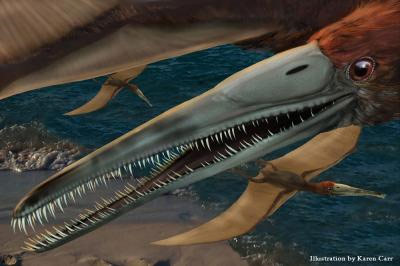New Species of Ancient Flying Reptile Discovered

An ancient reptile with a 9-foot wingspan was soaring over the sea in what is now North Texas some 95 million years ago when – plop – it fell into the water and died.
That paleo-death tale comes from a fossilized jaw that was discovered embedded in soft, powdery shale that had been exposed by excavation of a hillside next to a highway in the Dallas-Fort Worth area in 2006.
Analysis of the jaw now suggests it belongs to a new-to-science genus and species of flying reptile or pterosaur, now called Aetodactylus halli after its discoverer Lance Hall, a member of the Dallas Paleontological Society who hunts fossils for a hobby.
"I was scanning the exposure and noticed what at first I thought was a piece of oyster shell spanning across a small erosion valley," Hall said. "Only about an inch or two was exposed. I almost passed it up thinking it was oyster, but realized it was more tan-colored like bone. I started uncovering it and realized it was the jaw to something — but I had no idea what. It was upside down and when I turned over the snout portion it was nothing but a long row of teeth sockets, which was very exciting."
Paleontologists later told Hall it was a pterosaur (a group of flying reptiles commonly referred to as pterodactyls) and an important find. Such "winged lizards," as their name suggests, are thought to have dominated the skies from more than 200 million years ago until the mass extinction event 65 million years ago that wiped them out along with most dinosaurs and many other plants and animals.
A. halli is also one of the youngest members of the pterosaur family Ornithocheiridae.
The mandible, which is about 15 inches (38 centimeters) long, originally contained 54 slender, pointed teeth, but only two remained in their sockets when discovered, according to paleontologist Timothy S. Myers of Southern Methodist University (SMU) in Dallas, who identified and named the animal.
Get the world’s most fascinating discoveries delivered straight to your inbox.
From the way the teeth were spaced, the researchers suspect the upper and lower teeth interlaced when the jaws were closed. Just the fact that this pterosaur had teeth was somewhat surprising as all North American pterosaurs were toothless from that time period, except for Coloborhynchus.
When A. halli was alive, much of Texas was cloaked by the Western Interior Seaway – the massive sea that split North America from the Gulf of Mexico to the Arctic Ocean. On shore, the terrain was flat and dotted with flowering plants, according to paleobotanist Bonnie Jacobs, associate professor of Earth Sciences at SMU.
"There were still conifers and ferns as well, but mostly of the sort that had tiny needle leaves, like junipers," Jacobs said. "Sycamores and their relatives would have been among the flowering plants."
The team describes the flying reptile in the latest issue of the Journal of Vertebrate Paleontology.
- Gallery: 25 Amazing Ancient Beasts
- Avian Ancestors: Dinosaurs That Learned to Fly
- How Huge Flying Reptiles Got Airborne
Jeanna Bryner is managing editor of Scientific American. Previously she was editor in chief of Live Science and, prior to that, an editor at Scholastic's Science World magazine. Bryner has an English degree from Salisbury University, a master's degree in biogeochemistry and environmental sciences from the University of Maryland and a graduate science journalism degree from New York University. She has worked as a biologist in Florida, where she monitored wetlands and did field surveys for endangered species, including the gorgeous Florida Scrub Jay. She also received an ocean sciences journalism fellowship from the Woods Hole Oceanographic Institution. She is a firm believer that science is for everyone and that just about everything can be viewed through the lens of science.


